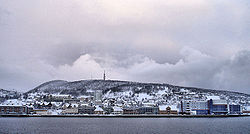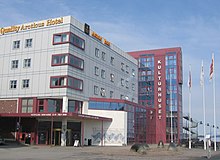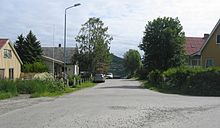Harstad Municipality
Harstad Municipality
Harstad kommune | |
|---|---|
 Harstad during the winter of 2005–2006 | |
 Harstad within Troms | |
| Country | Norway |
| County | Troms |
| District | Central Hålogaland |
| Administrative centre | Harstad |
| Government | |
| • Mayor (2013) | Marianne Bremnes |
| Area | |
| • Total | 445.86 km2 (172.15 sq mi) |
| • Land | 429.06 km2 (165.66 sq mi) |
| • Water | 16.8 km2 (6.5 sq mi) |
| • Rank | #249 in Norway |
| Population (2012) | |
| • Total | 23,640 |
| • Rank | #38 in Norway |
| • Density | 66.5/km2 (172/sq mi) |
| • Change (10 years) | |
| Demonym | Harstadværing[1] |
| Official language | |
| • Norwegian form | Neutral |
| Time zone | UTC+01:00 (CET) |
| • Summer (DST) | UTC+02:00 (CEST) |
| ISO 3166 code | NO-1903[3] |
| Website | Official website |
is the second-most populated municipality in Troms county, Norway. It is mostly located on the large island of Hinnøya. The municipal center is the town of Harstad, the most populous town in Central Hålogaland, and the third-largest in all of Northern Norway.[4][5] The town was incorporated in 1904. Villages in the municipality include Elgsnes, Fauskevåg, Gausvik, Grøtavær, Kasfjord, Lundenes, Nergården and Sørvika.
Geography

The municipality is located on many islands in southern Troms county. Most of the municipality is located on the large island of Hinnøya, which is Norway's largest coastal island (three islands in the Svalbard archipelago are larger). The northern part of the municipality is located on the smaller islands of Grytøya, Bjarkøya, Sandsøya, Helløya, Flatøya and Krøttøya and many even smaller islands between the Andfjorden (to the west) and the Vågsfjorden (to the east). The municipality contains several small islands, including Arnøya, Gressholman, Helløya, Kjeøya, Kjøtta, Kjøttakalven, Flatøya, Meløyvær, Måga, Rogla, Lille Rogla and Åkerøya.
Harstad is bordered by the municipality Kvæfjord to the west and Tjeldsund (in Nordland county) to the south. To the southeast, the Tjeldsund Bridge connects Hinnøya with Skånland municipality and the mainland across Tjeldsundet, and to the northeast is the Vågsfjorden, where Harstad shares a water border with Ibestad municipality. The city itself is located on the northeastern part of on Hinnøya; it is the only city on the island, and is popularly known as Vågsfjordens perle (The pearl of Vågsfjorden).
The highest mountain in Harstad is Sætertinden, which is 1,095 m (3,593 ft) above sea level.[6] It is located near the village of Sandtorg in southern Harstad. The 412-metre (1,352 ft) tall mountain, Nupen, is located in the northwestern part of the municipality on the border with Kvæfjord.
Climate and light
Despite being located north of the Arctic Circle, Harstad features a subpolar oceanic climate with relatively mild winters and cool summers. Harstad does not have the brutal winters that most locations north of the Arctic Circle experience, and is sheltered from Atlantic gales by mountains in west, and has the main part of the Scandinavian Mountains to the east. The city experiences warmer winters than major cities located 25 to 30 degrees farther south in latitude in the northern hemisphere such as Beijing, Chicago and Toronto. Summers in Harstad are cool, with average high temperatures seldom breaking the 22 °C (72 °F) mark. Since the new weather station opened in August 2002, July 2014 was the warmest month with 6 days above 27 °C (81 °F) and a new all-time high of 31.7 °C (89 °F) on 10 July. The record low of −16.1 °C (3 °F) was recorded in February 2010.
The city enjoys the midnight sun during the summer months, from 22 May to 18 July. There is also a period from early May to early August with twilight for a few hours each night as the sun just dips below the horizon, so there is no darkness. The polar night, when the sun is always below the horizon, lasts from 30 November to 12 January. At this time, there are 3–4 hours of dawn and dusk around noon, sometimes with colourful skies towards the south. From late January, the period of daylight rapidly increases, reaching 12 hours by March and 18 hours in April. Harstad is located in the midst of the aurora borealis (a.k.a. the northern lights) zone, and the aurora can often be seen on clear nights, but not in summer due to the continuous daylight.
| Climate data for Harstad (45 m, avg temperatures 10 last years, extremes 2002 - 2015) | |||||||||||||
|---|---|---|---|---|---|---|---|---|---|---|---|---|---|
| Month | Jan | Feb | Mar | Apr | May | Jun | Jul | Aug | Sep | Oct | Nov | Dec | Year |
| Record high °C (°F) | 8.8 (47.8) |
8.5 (47.3) |
10.9 (51.6) |
16.9 (62.4) |
23.9 (75.0) |
26.8 (80.2) |
31.7 (89.1) |
26.5 (79.7) |
21.3 (70.3) |
17.5 (63.5) |
13.8 (56.8) |
9.2 (48.6) |
31.7 (89.1) |
| Mean daily maximum °C (°F) | 0 (32) |
−1 (30) |
1 (34) |
5 (41) |
9 (48) |
12 (54) |
16 (61) |
15 (59) |
10 (50) |
6 (43) |
3 (37) |
1 (34) |
6 (44) |
| Mean daily minimum °C (°F) | −4 (25) |
−4 (25) |
−3 (27) |
1 (34) |
5 (41) |
8 (46) |
12 (54) |
11 (52) |
7 (45) |
2 (36) |
0 (32) |
−2 (28) |
3 (37) |
| Record low °C (°F) | −14.7 (5.5) |
−16.1 (3.0) |
−13.3 (8.1) |
−9.4 (15.1) |
−2.8 (27.0) |
0.9 (33.6) |
4.6 (40.3) |
1.7 (35.1) |
−1.6 (29.1) |
−7.9 (17.8) |
−10.3 (13.5) |
−14.5 (5.9) |
−16.1 (3.0) |
| Average precipitation mm (inches) | 85 (3.3) |
80 (3.1) |
65 (2.6) |
50 (2.0) |
35 (1.4) |
37 (1.5) |
53 (2.1) |
58 (2.3) |
80 (3.1) |
110 (4.3) |
97 (3.8) |
100 (3.9) |
850 (33.5) |
| Source 1: [7] | |||||||||||||
| Source 2: [8] | |||||||||||||
History



The town of Harstad was established as a municipality on 1 January 1904 when it was separated from the municipality of Trondenes. The initial population of the town of Harstad was 1,246. On 1 January 1964, the municipalities of Sandtorg, Trondenes, and Harstad were merged to form a new, combined municipality with a population of 17,882. Prior to the merger, Harstad had 3,808 residents.[9] On 1 January 2013, the municipality of Bjarkøy (to the north) was merged with Harstad, forming a new, larger municipality of Harstad.
In recent years, a 3000-year-old bronze axe[10] and a 2600-year-old bronze collar[11] have been found at the Trondenes peninsula, just north of the city center. These, together with the burial cairns built close to the sea, are indications of a well-developed Bronze Age culture in the Harstad area.
There is also substantial archeological evidence of a well-developed Iron Age culture in the area, around 200 AD.
Trondenes is mentioned in the Heimskringla as a power centre in the Viking Age and a place to meet and discuss important issues (Trondarting).
Trondenes Church, the world's northernmost medieval church, which dates back to the 13th–15th century, is situated just outside the town.

Adjacent to the church is the Trondenes Historical Center and nearby is the Adolf Gun, an enormous land-based cannon from World War II, and the last of four cannons originally constructed by the Nazis. Harstad is one of the few towns in this part of Norway which were left largely undamaged by World War II.
Origin of the name
The city is named after the old Harstad farm (Old Norse: Harðarstaðir), since it is built on its ground[citation needed]. The first element is (probably) the genitive case of the male name Hǫrðr, and the last element is staðir which means "homestead" or "farm".[12]
Coat-of-arms
The coat-of-arms is from modern times and were granted on 24 April 1953. The blue background symbolizes the sea and the silvery white lines represent waves.[13]
Government
All municipalities in Norway, including Harstad, are responsible for primary education (through 10th grade), outpatient health services, senior citizen services, unemployment and other social services, zoning, economic development, and municipal roads. The municipality is governed by a municipal council of elected representatives, which in turn elect a mayor.
Municipal council
The municipal council (Kommunestyre) of Harstad is made up of 35 representatives that are elected to every four years. Currently, the party breakdown is as follows:[14]
| Party name (in Norwegian) | Number of representatives | |
|---|---|---|
| Labour Party (Arbeiderpartiet) | 13 | |
| Progress Party (Fremskrittspartiet) | 8 | |
| Green Party (Miljøpartiet De Grønne) | 1 | |
| Conservative Party (Høyre) | 4 | |
| Christian Democratic Party (Kristelig Folkeparti) | 1 | |
| Red Party (Rødt) | 1 | |
| Centre Party (Senterpartiet) | 2 | |
| Socialist Left Party (Sosialistisk Venstreparti) | 1 | |
| Liberal Party (Venstre) | 4 | |
| Total number of members: | 35 | |
Economy
The oil industry of North Norway is centered in Harstad; including Statoil's main office for a new operational area for Northern Norway,[15] the DNV office for Northern Norway,[16] as well as other regional offices including Total E&P,[17] Det Norske Oljeselskap ASA[18] and Aibel.[19][20] Harstad also has shipyards and other industries that are important for the economy. Harstad and the surrounding area have traditionally been among the most productive agricultural regions in Northern Norway,.[21] The old seabed, now dry land due to isostatic rebound (up to 60 to 80 metres or 200 to 260 feet above sea level), creating fertile soil that is well-suited for farming.[22]

Institutions and culture

The city hosts the annual week-long Festival of North Norway in June.[23]
Harstad University College, with approximately 1,100 students,[24] has a thriving foreign exchange program with students from all over the world. The hospital in Harstad is part of the University Hospital of North Norway.
The most successful local football team is Harstad Idrettslag (a.k.a. HIL),[25] and the most successful basketball team is the Harstad Vikings.[26]
Harstad is home port for the Anna Rogde, the world's oldest sailing schooner, also known as the sailing queen of Norway.[27]
Harstad Camping is a campsite located in the municipality.
Churches
The Church of Norway has five parishes (sokn) within the municipality of Harstad. It is part of the Trondenes deanery in the Diocese of Nord-Hålogaland.
| Parish (Sokn) | Church Name | Location of the Church | Year Built |
|---|---|---|---|
| Bjarkøy og Sandsøy | Bjarkøy Church | Nergården | 1766 |
| Sandsøy Church | Sandsøya | 1888 | |
| Grytøy | Grøtavær Church | Grøtavær | 1915 |
| Lundenes Church | Lundenes | 1974 | |
| Harstad | Harstad Church | Harstad | 1958 |
| Kanebogen | Kanebogen Church | Kanebogen | 1999 |
| Sandtorg | Gausvik Church | Gausvik | 1979 |
| Sandtorg Church | Sørvika | 1932 | |
| Trondenes | Trondenes Church | Trondenes | 15th century |
| Elgsnes Chapel | Elgsnes | 1985 |
Military connections
Harstad traditionally has strong ties with the Norwegian Armed Forces. Kystjegerkommandoen (Coastal Ranger Command) has its home base at Trondenes, Harstad. Marinejegerkommandoen is based in Ramsund in Tjeldsund on the mainland south of Harstad. General Carl Gustav Fleischer led the field operations of the Norwegian Armed Forces in WW2, among them the 7,500 soldiers which from the north pushed the Nazi Germans back to Narvik and participated in retaking Narvik on 28 May 1940. A street in Harstad is named Gen. Fleischers Gate in his honour.
Operation Judgement, Kilbotn took place on 4 May 1945, when the Fleet Air Arm of the Royal Navy attacked a U-boat base at Kilbotn, a village in the Harstad district, sinking two ships and a U-boat.
Harstad is also the hometown of the Norwegian army band "Forsvarets Musikkorps Nord Norge" with professional musicians.
Transportation

The closest airport is Harstad/Narvik Airport, Evenes, located on the mainland, 44 kilometres (27 mi) by road from the city center.[28]
Every morning a northbound and a southbound Hurtigruten ship stop in Harstad.[29]
High-speed craft regularly go between Harstad and Tromsø, Finnsnes, Senja and other places.[30]
There are several ferries and buses in the district, and in Harstad there are local buses.[30]
The leading helicopter company in Northern Norway, Heli-Team, is located in Harstad.[31]
Local areas


- Villages north/west of the city
Alvestad, Aune, Elgsnes, Ervik, Grøtavær, Hagan, Kasfjord, Kilhus, Kjøtta, Lundenes, Mustaparta, Nergården, Røkenes, Steinnes, Stornes, Storvassbotn, Sørlia, Tennvassåsen, Tømmeråsen, Undlandet, Vika and Årnes.
- City neighbourhoods
Bergseng, Blåbærhaugen, Breivika, City Center, Eineberget, Gangsås, Grønnebakkan, Harstadbotn, Harstadåsen, Heggen, Holtet, Kanebogen, Kilbotn, Medkila, Ruggevika, Sama, Seljestad, Skaret, Stangnes, Trondenes and Åsby.
- Villages south of the city
Brokvik, Fauskevåg, Gausvik, Halsebø, Haukebø, Melvik, Nordvik, Sandtorg and Sørvika.
Notable residents


- Knut Andersen (1931–), film director
- Elisabeth Aspaker (1968-), politician. Minister of Fisheries
- Bjarne Berg-Sæther (1919–2009), mayor, county mayor
- Trygve Bornø (1942–), former national football player
- Kristin Clemet (1957–), politician, former Minister of Education
- Hans Egede (1686–1758), priest, the Apostle of Greenland
- Karl Erik Harr (1940–), painter
- Kine Hellebust (1954–), singer
- Leif Arne Heløe (1932–), former Minister of Social Affairs
- Rikard Kaarbø (1850–1901), businessman and politician
- Thea Floer Kulseng (2003–), winner of Melodi Grand Prix Junior 2015
- Hanna Kvanmo (1926–2005), politician
- John Bernhard Rekstad (1852–1934), geologist
- Iren Reppen (1965–), actress
- Iselin Steiro (1985–), model
- Unni Wikan (1944–), professor of social anthropology
- Sandra Meland (1995-), singer
International relations


Twin towns — Sister cities
The twin towns of Harstad are:[32]
See also
References
- ^ "Navn på steder og personer: Innbyggjarnamn" (in Norwegian). Språkrådet.
- ^ "Forskrift om målvedtak i kommunar og fylkeskommunar" (in Norwegian). Lovdata.no.
- ^ Bolstad, Erik; Thorsnæs, Geir, eds. (26 January 2023). "Kommunenummer". Store norske leksikon (in Norwegian). Kunnskapsforlaget.
- ^ Municipality second largest in Troms county, by population
- ^ City second largest in Troms county; third largest in Northern Norway
- ^ "Sætertinden".
- ^ "Harstad average conditions - base period 10 last years". Storm Weather Center. Retrieved 26 November 2009.
- ^ "Eklima/met.no". Norwegian Meterological Institute. Retrieved 10 September 2016.
- ^ Jukvam, Dag (1999). "Historisk oversikt over endringer i kommune- og fylkesinndelingen" (PDF) (in Norwegian). Statistisk sentralbyrå.
- ^ "Bronze axe".
- ^ "Bronze collar".
- ^ Rygh, Oluf (1911). Norske gaardnavne: Troms amt (in Norwegian) (17 ed.). Kristiania, Norge: W. C. Fabritius & sønners bogtrikkeri. p. 21.
- ^ "Harstad kommunes byvåpen" (in Norwegian). Harstad kommune. Retrieved 2 December 2008.
- ^ "Table: 04813: Members of the local councils, by party/electoral list at the Municipal Council election (M)" (in Norwegian). Statistics Norway. 2015.
- ^ http://www.statoil.com/en/NewsAndMedia/News/2012/Pages/21Mar_DriftHarstad.aspx
- ^ http://www.offshore-mag.com/articles/2012/05/dnv-increases-arctic-focus.html
- ^ http://www.total.no/normal/En/about/org/Pages/Home.aspx
- ^ http://www.detnor.no/#
- ^ http://aibel.com/en/news-and-media/press-releases/billion-nok-contract-gives-aibel-six-years-on-draugen
- ^ http://aibel.com/en/about/locations/harstad
- ^ http://www.destinationharstad.no/hno/Kommuner/Kvaefjord
- ^ http://www.skogoglandskap.no/filearchive/Rapport_02_98.pdf
- ^ "Festspillene i Nord-Norge".
- ^ "Harstad University College".
- ^ "HIL" (in Norwegian).
- ^ "Harstad Vikings" (in Norwegian).
- ^ "Anna Rogde" (in Norwegian).
- ^ Harstad/Narvik Lufthavn Evenes. supersaver.no. Accessed 2011-06-11.
- ^ Coastal Express. hurtigruten.com. Accessed 2011-10-14.
- ^ a b Troms fylkestrafikk. tromskortet.no. Accessed 2011-06-30.
- ^ Heli-Team. heliteam.no.
- ^ "Twin towns". Choose English > Political info > Friendship cities
External links
 Harstad travel guide from Wikivoyage
Harstad travel guide from Wikivoyage- Information in English Harstad municipality
- Visit Harstad
- Culture
- Old history of Harstad
- Harstad pictures
- Green and black aurora over Harstad NASA astronomy picture of the day
- Particularly rare purple auroral corona over Harstad NASA astronomy picture of the day
- Web-cam Showing various parts of the town
- Photo presentation on YouTube
- The Adolf Cannon
- Art of the States: Frozen Horizon Musical work inspired by the Harstad landscape
- Harstad Tidende (Harstad Times) Newspaper for the district Template:No icon
- iHarstad.no Information portal Template:No icon
- Live weather station located in Harstad Template:No icon
- About Hinnøy Template:No icon
- Magnars garden at 69 degrees north Template:No icon



